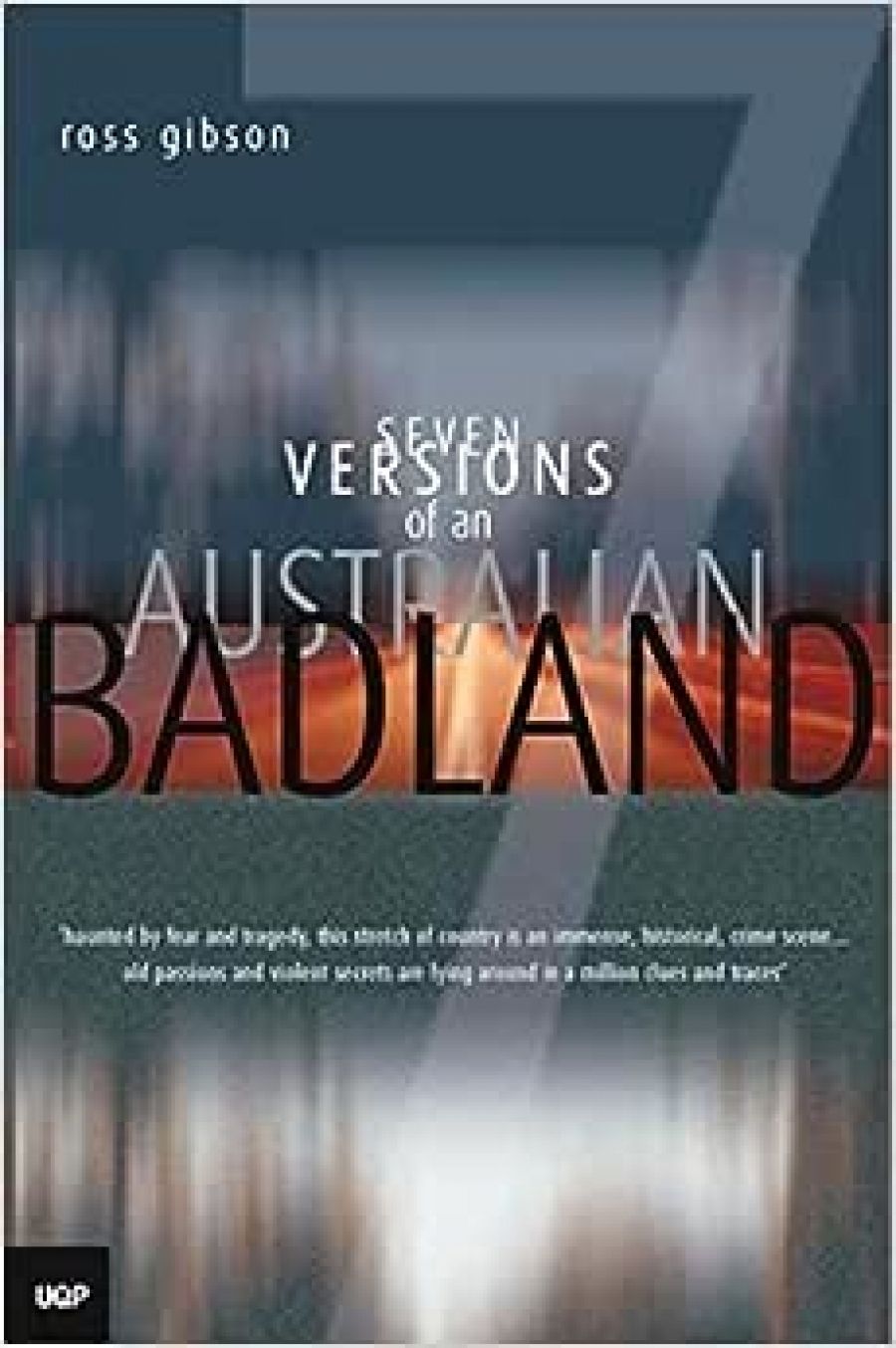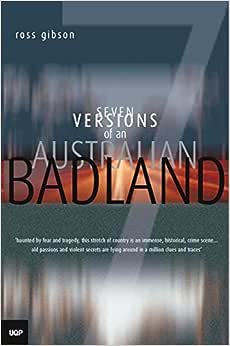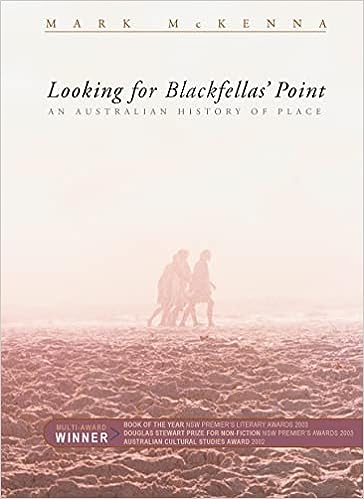
- Free Article: No
- Contents Category: Australian History
- Review Article: Yes
- Article Title: Culture of Forgetting
- Online Only: No
- Custom Highlight Text:
The idea of place as a metaphor of Australia’s colonial past and post-colonial present is a recent development in Australian history. The three books reviewed here come from a new generation of cultural historians who want to move the story of Australia from the national to the local. These cultural historians’ books reveal an intimacy with place and a new confidence in connecting the past to the present.
- Book 1 Title: Seven Versions of An Australian Badland
- Book 1 Biblio: UQP, $19.95pb. 208pp
- Book 1 Cover Small (400 x 600):

- Book 2 Title: Looking For Blackfellas’ Point
- Book 2 Subtitle: An Australian History of Place
- Book 2 Biblio: UNSW Press, $39.95pb, 286pp
- Book 2 Cover Small (400 x 600):

- Book 3 Title: Unearthed
- Book 3 Subtitle: The Aboriginal Tasmanians of Kangaroo Island
- Book 3 Biblio: Wakefield Press, $29.95pb, 385pp
- Book 3 Cover Small (400 x 600):

Such a story is bound to hurt and dismay many descendants of Aboriginal and non-Aboriginal families. Taylor has had to change the names of many of the key players. But the fine detail offers clues to understanding how so many white Australians have been unable to engage with the contradictions and ambiguities of the past. Taylor is relentless in her search for understanding, but sometimes admits she can take the story no further. This book breaks new ground in exploring the historical experiences of small communities with cross-cultural histories.
The journey from Kangaroo Island to the ‘horror stretch’ of road between Marlborough and Sarina in eastern central Queensland is like travelling from an island of mystery to a place of unmitigated evil. In Seven Versions of an Australian Badland, Ross Gibson represents the story of this part of Australia in a series of horrifying yet fascinating sketches of human brutality as a way of learning ‘hard lessons about a society recovering from colonialism’. Gibson first looked at this country from the back window of his father’s car in the 1960s, and was fascinated by its almost mythic horror. He began to track the landscape ‘on a private quest to know a worthless stretch of scrubby floodplain. But before long, the quest became an inquest.’ Subsequent research confirmed his first impressions and form the backdrop for his seven stories. They include the gruesome murders of travellers along the horror stretch in the 1960s and 1970s, the massacre of Aborigines in the mid-nineteenth century, the deaths of Melanesian labourers a few decades later, the story of the white man who became an Aborigine, and the desperate lives of the European migrants on the cane fields. Each generation of colonialism in this part of Australia has its own shocking story.
While Gibson gives the impression that the ‘horror stretch’ is bad country full of bad vibes, he is relentless in his search to understand how and why it consumes so many who have been associated with it. It is as if the past rules this stretch of country like a demon who must be confronted and removed before the region and its people can recover.
In his role as exorcist, Gibson uses his narrative skills as a cultural historian and his knowledge of the physical terrain to confront the demon. His ruthless storytelling sometimes appears more like popular history than considered reflection. But this is Queensland, where the mythic, the popular and the brutal combine in often frightening ways. As if to outsmart the devil, Gibson zigzags the narrative from the present to the past and back again with dazzling skill, as if to show that the devil of the past is always present. This is Gibson at his best.
Does he exorcise the devil? Are the badlands of Central Queensland still with us? Gibson is not sure. He writes: ‘the closer I’ve looked, the more the place has come into focus as a mythological badland, a paradoxically real and fantastic location where malevolence is simply there partly because it has long been imagined there.’ At the end of the book, he warns the reader ‘to brace yourself for the next episode’.
At first glance. the south coast of New South Wales is far removed in time and place from the ‘horror stretch’ of Central Queensland. Indeed, for holiday-makers from Canberra, the ‘south coast’ has no history. But, when the historian Mark McKenna ‘discovered’ this country in the late 1980s, he quickly found that it had a past that could provide rich insights into understanding the present. Looking for Blackfellas’ Point is the story of his personal journey to discover how the process of colonisation in this region had shaped the Australian psyche in the late twentieth century.
McKenna places his story against the backdrop of thirty years of research into Aboriginal history, and particularly the work of Henry Reynolds. For example, he can verify few stories of frontier brutality on the far south coast of New South Wales, but acknowledges that there are far too many for them all to be fabrications. He disputes Reynolds’s claim that British policy in the 1830s implied that the pastoralists had a moral responsibility to observe Aboriginal use of the land. Rather, he finds that the squatters in ‘his’ region were convinced they had a moral right to dispossess the Aboriginal people. But McKenna agrees with Reynolds that the process of dispossession scarred men and women on both sides of the frontier in often horrifying ways. This in tum led to a culture of forgetting. On the far south coast of New South Wales, Aboriginal people became invisible and white people repressed their experiences of the colonial encounter. His stories of their descendants in the twentieth century, struggling to create a painless history in order to avoid confronting the past, are among the book’s most powerful.
McKenna writes not with the suppressed rage of an earlier generation of historians, but with a puzzled compassion about Australians he loves and respects. He wants to understand the past rather than apportion blame. This is a finely etched history that moves beyond personal experience to a deeper understanding of a human landscape. McKenna’s story is a metaphor for Australia’s search for reconciliation through sharing a perspective and a sense of place, and journeying toward a future meeting point where Australians might find a history that explains what they have become and why some wish now for reconciliation.
All three books are based on the authors’ intimate knowledge of the human landscape in their particular region, yet they have not been afraid to employ the insights of outsiders, so their stories can resonate in the national context. From this vantage point, they reflect a deeper understanding of the complexities of the past, and how the culture of forgetting has shaped the present. Each offers new ways of confronting and reconciling this past and moving on to the future.


Comments powered by CComment